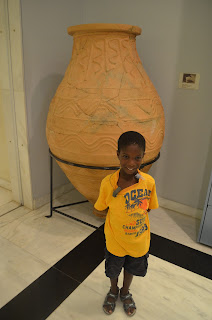Classes over! We have crammed in years of course work in
history, geography, theology and international politics into 6 weeks. At the same time, we have spent invaluable
time with one another. We have been enriched by the experience in ways we
planned as well as in ways that that we will never know. We thank God for this spectacular opportunity
and the staff at the office for holding down the fort in our absence. We are forever
grateful to them!!
We made it safely to MN! To God be the Glory!!!!
As we settle into regular routine, we now begin to imagine what, if any territory Ojemba will conquer next year. Further east—China; closer to the mother continent, Africa;
or other parts of our adopted country, United States. Or stay in MN.
Thoughts on Greece
This Ojemba blogpost will be incomplete without comments on Greece and its
people and how our experience in Greece compares with the Turkey experience. First,
we found the people of Greece very welcoming, generous and interesting.
The relationship between the two countries is a very
delicate subject, and which we can’t wade into here. But the centuries’ old
rivalry with Turkey is more palpable in Greece than in Turkey. It is a sour subject
to bring up Turkey, or tell locals that you visited Turkey and had a good time
there. And for sure, do not mistake the countries or their cities in conversations. One
Greek driver’s first question was: honestly, what do they think about us; they still
believe that Greece belongs to them. The
Ottoman Empire may have ruled part or all of modern day Greece for better part
of 400 years, but that was a long time ago. It is Ojemba's opinion that there may be some parallels between
the relationships of these two counties and that of India and Pakistan. It doesn’t help that for the Greeks, Istanbul
or Constantinopolis as they still refer to it, is the seat of the Greek Orthodox
Church and remains of religious significance.
The Turks seemed a little miffed about not being able to join the EU (and maybe rightly so) but
mostly relaxed about Greece except on the Cyprus question but even then they
have lots of other and more pressing issues – Syria, the Kurds, etc. It probably helps that their economy is
booming so they can relax and enjoy the good times.
The economic crisis in Greece seems to have had a huge impact on the
locals. Though we did not have the privilege of visiting Greece before the
financial meltdown, it appears to us that this place has been hit real, real hard.
It is visible everywhere you look. Graffiti all over Athens gives a wrong vibe
about this place, and makes it unattractive; which does not help the tourism industry. Some guides estimate a reduction
of about 40 percent in tourism between 2011 and 2012. And there is no end in sight.
Conversations with locals inevitably veer
towards the subject of politics. With problems ranging from school closures, high unemployment,
hooliganism and the effect of the Euro currency on the Greek economy, it is easy to understand why people will question the rationale of
remaining in the Euro zone. While in Turkey we saw a vibrant economy, robust
infrastructural investment, in Greece those are lacking. And with the Euro, it
is more expensive to visit here than Turkey. At the end, the destiny of Greece
lies with Greeks.
It is difficult to imagine this problem being solved while
Greece continues using the Euro currency. All creditors, foreign and domestic
have to agree on that the survival of the economy is so important that they
agree to wipe out most if not all their debt—not just giving the country a new
payment plan. This is highly unlikely.
Some minor setbacks we encountered:
We got a speeding ticket on our way from Sanliurfa to Gazientep.
Fine 138 Turkish Lira. The officers thought it was hilarious that we could not communicate
with one another. They gave Paschal a glass of cold water, and with broken
English communicated the offense and punishment. Got the ticket, and had to
give the rental car guy the money to settle the ticket.
On our way back, we misjudged the gas reserve we had in our
car. While running out of benzene gas, we stopped by a couple of Patrol
stations who told us that we had to drive several kilometers before we can get
the gas. Some stations that sell Patrol do not sell benzene. We finally ran into an entrepreneurial young man who solved the problem for us. We backed into the back
of a neighbor shop and they siphoned benzene gas into our car – “just like buying
petrol on the road in naija”. Thank God
it was not adulterated fuel.
Healthwise, we had a good trip. A few allergic reactions to nuts – Carrying around
Piriton was a life saver. Otherwise, a
few cuts and bruises – nothing major.
However, one of the kids brought strep with them from the US and we noticed
the scarlet fever bumps while still in Istanbul but did not connect it to
strep. After a week of progressively
getting worse, we finally made the connection – we got antibiotics from the
pharmacist and then everything cleared up.























































